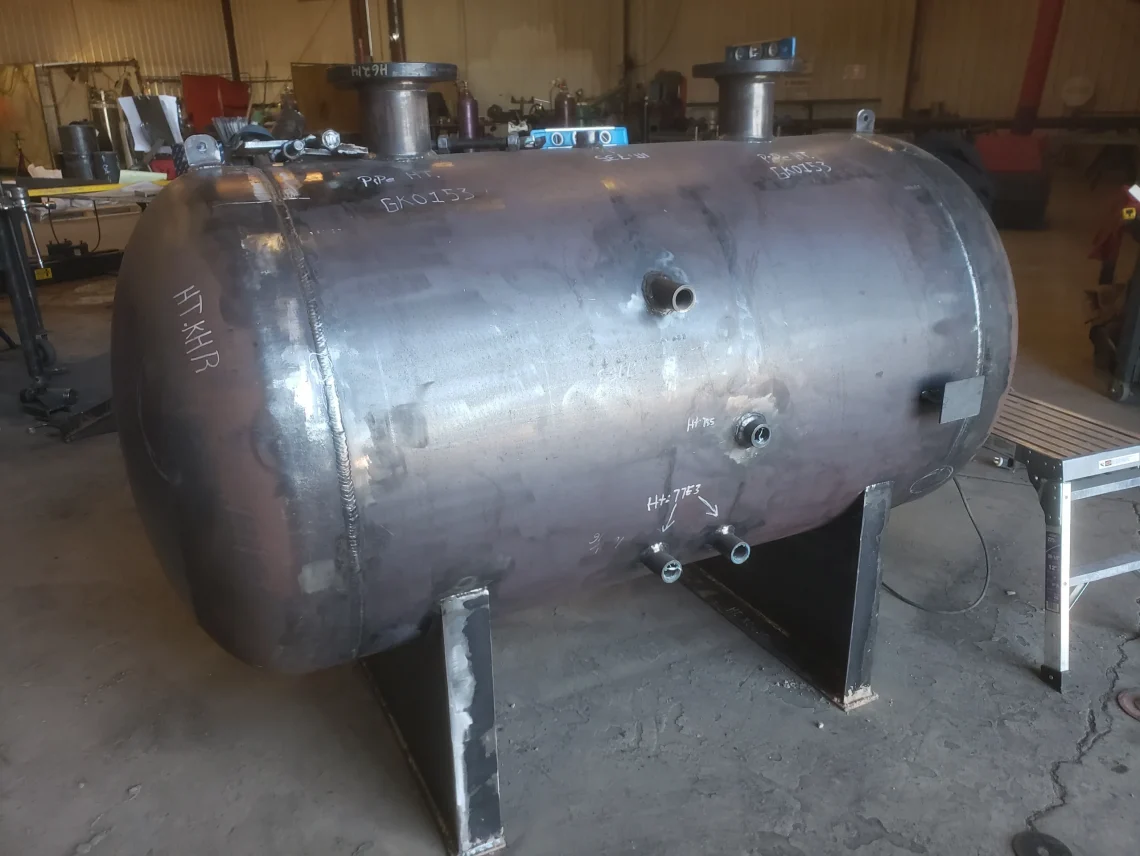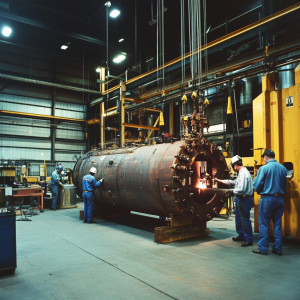Pressure vessel fabrication activitiesWhat Are the Pressure Vessel Fabrication Activities?

Table of Contents
ToggleUnderstanding Pressure Vessel Fabrication
Pressure vessels are essential components in various industrial processes, containing gases or liquids at pressures significantly different from ambient conditions. Their design, fabrication, and inspection are subject to stringent standards due to the potential hazards associated with pressure-related failures.
At its core, pressure vessel fabrication is a meticulous process transforming raw materials into high-performance containment systems. Whether used in oil refineries, chemical plants, or power stations, the integrity of a pressure vessel directly impacts the safety and efficiency of the operation.
The fabrication of pressure vessels follows a well-defined sequence of activities governed by standards such as the ASME Boiler and Pressure Vessel Code (BPVC), particularly Section VIII. Understanding these activities is crucial for stakeholders seeking dependable and compliant vessels.
For more information about Red River’s dedication to American-made quality and precision, explore our homepage.
Step-by-Step Fabrication Process

1. Engineering Design & Material Selection
Every successful pressure vessel starts with robust engineering. This stage involves determining the operating parameters—pressure, temperature, fluid type, and environmental factors. Engineers use these parameters to calculate wall thickness, select design codes, and choose suitable materials.
Key considerations include:
- Corrosion resistance
- Strength-to-weight ratio
- Cost-effectiveness
- Weldability and machinability
Material selection typically involves carbon steel, stainless steel, or specialty alloys like Hastelloy or Inconel, depending on the operating conditions.
2. Cutting and Forming
Once materials are procured, fabrication begins with cutting the plates into required dimensions using plasma, laser, or waterjet cutting technologies. This ensures high precision and minimal waste.
Next, forming operations shape the plates into cylindrical shells or heads. Heads may be:
- Ellipsoidal (2:1 elliptical): Ideal for most pressure applications.
- Hemispherical: Offers uniform stress distribution, used in high-pressure vessels.
- Torispherical: Cost-effective, suitable for moderate pressure.
The forming process can involve cold rolling or hot forming, depending on the thickness and material properties.
3. Welding
Welding is perhaps the most critical phase in fabrication. It joins formed sections together and must meet both structural and pressure containment requirements.
Common welding methods include:
- Shielded Metal Arc Welding (SMAW)
- Gas Tungsten Arc Welding (GTAW/TIG)
- Submerged Arc Welding (SAW)
Weld joints are designed based on stress analysis and accessibility for inspection. Welders must be qualified per ASME Section IX, and welding procedures are rigorously documented.
4. Heat Treatment
Post-weld heat treatment (PWHT) is used to relieve stresses introduced during welding. It involves heating the vessel to a specified temperature and holding it for a set time, followed by controlled cooling.
PWHT enhances ductility, reduces hardness, and minimizes the risk of brittle fracture. The necessity of PWHT depends on the material, thickness, and design code requirements.
5. Surface Treatment and Coating
After fabrication and PWHT, surface treatment ensures the vessel resists corrosion and contamination. Common processes include:
- Sandblasting: Removes mill scale and impurities
- Passivation: Improves corrosion resistance for stainless steel
- Painting and coating: Uses epoxy or polyurethane paints for external protection
Coatings are selected based on service conditions and industry standards (e.g., NACE MR0175 for sour service).
6. Inspection and Testing
Quality assurance is a cornerstone of pressure vessel fabrication. Inspections begin with dimensional checks and visual examinations, followed by advanced testing techniques:
Non-Destructive Testing (NDT) methods:
- Radiographic Testing (RT): Detects internal weld flaws
- Ultrasonic Testing (UT): Measures wall thickness and detects discontinuities
- Dye Penetrant Testing (PT): Identifies surface cracks
- Magnetic Particle Testing (MT): Reveals surface and near-surface defects in ferromagnetic materials
After NDT, vessels undergo pressure testing:
- Hydrostatic Test: Fills vessel with water and pressurizes it to 1.3–1.5x design pressure
- Pneumatic Test: Uses air or inert gas; more hazardous, so used cautiously
7. Documentation and Compliance
The final phase involves compiling detailed documentation, which includes:
- Welding Procedure Specifications (WPS)
- Welder Qualification Records (WQR)
- Material Test Reports (MTR)
- Inspection and test reports
- Code compliance certificates
Traceability is paramount, ensuring that every material and weld can be traced back to its source and specification. This is essential not just for quality but also for regulatory audits.
From Design to Deployment, Every Step Matters
Pressure vessel fabrication is far more than a series of mechanical steps. It is a synchronized dance of engineering excellence, skilled craftsmanship, and rigorous quality assurance. Each phase—from selecting the right material to passing the final pressure test—contributes to building vessels that perform reliably under demanding conditions.
For those seeking trusted partners in the fabrication journey, Red River offers not just technical expertise but a commitment to values, transparency, and American-made quality.
Explore more about our services and approach at Red River.
Need a reliable partner?
Red River specializes in the design and manufacturing of pressure vessels. We also fabricate related items such as prefabricated spools and skid packages.
Reach out to us today and experience the Red River difference. Where American-made products and American Values come together, we care more.
Frequently Asked Questions
1. What industries require pressure vessel fabrication?
Industries such as oil & gas, chemical processing, power generation, food & beverage, and pharmaceuticals rely on pressure vessels for storage, reaction, and separation tasks.
2. How long does it take to fabricate a pressure vessel?
Fabrication timelines range from several weeks to months, depending on size, complexity, material, and compliance requirements.
3. What codes govern pressure vessel fabrication?
The primary code is the ASME Boiler & Pressure Vessel Code (Section VIII). Other standards may include API 510, PED (EU), and NACE for specific applications.
4. Why is heat treatment necessary after welding?
Heat treatment relieves residual stresses, reduces hardness, and improves the vessel’s mechanical performance, especially after high-energy welding.
5. What’s the difference between hydrostatic and pneumatic testing?
Hydrostatic uses water and is safer due to its incompressibility. Pneumatic uses air or inert gas and is more sensitive to leaks, but riskier due to stored energy.
6. Are all pressure vessels the same?
No, vessels are custom-engineered based on service conditions like pressure, temperature, and chemical compatibility.
7. What is the role of NDT in fabrication?
NDT ensures the integrity of materials and welds without damaging the vessel. It’s crucial for detecting hidden flaws.
8. Can pressure vessel fabrication be automated?
Some steps, like CNC cutting and robotic welding, can be automated, but experienced human oversight is vital for inspection and compliance.
Key Takeaways
- selection, welding, testing, and compliance.
- Each phase is vital in ensuring the vessel can safely operate under pressure.
- Strict adherence to ASME and other relevant standards is mandatory.
- Welding and inspection are particularly crucial for long-term vessel integrity.
- Traceable documentation assures customers and regulators of the vessel’s quality and reliability.
- Partnering with experienced fabricators like Red River guarantees precision, safety, and value.
Solutions
In the realm of industrial solutions, Red River emerges as a pioneer, offering a diverse range of custom-engineered products and facilities. Among our specialties is the design and production of Custom/OEM Pressure Vessels, meticulously crafted to meet individual client requirements, ensuring performance under various pressure conditions. Our expertise extends to the domain of prefabrication, where Red River leads with distinction.
The company excels in creating prefabricated facilities, modules, and packages, reinforcing its stance as a forerunner in innovation and quality. This proficiency is further mirrored in their Modular Skids offering, where they provide an array of Modular Fabricated Skid Packages and Packaged equipment. Each piece is tailored to client specifications, underlining their commitment to delivering precision and excellence in every project they undertake.
Need action? Ready to Get Started?
We are here to make it happen. Request a qoute!

